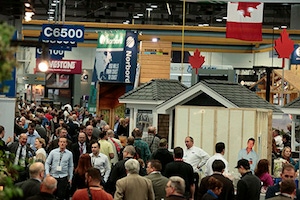Home, sweet plastic home
When you think of industries where plastics are in great demand, you might think of packaging or automotive. But one visit to the International Builders Show (IBS) gives you just a glimpse of the myriad applications for plastics in today's homes. The IBS is happening this week in Las Vegas, and it was perfect timing for SPI: The Plastics Industry Trade Association (Washington, DC) to publish Plastics Market Watch: Building and Construction, its fourth report in a series analyzing factors affecting the plastic industry's key end markets.
January 21, 2016

When you think of industries where plastics are in great demand, you might think of packaging or automotive. But one visit to the International Builders Show (IBS) gives you just a glimpse of the myriad applications for plastics in today's homes. The IBS is happening this week in Las Vegas, and it was perfect timing for SPI: The Plastics Industry Trade Association (Washington, DC) to publish Plastics Market Watch: Building and Construction, its fourth report in a series analyzing factors affecting the plastic industry's key end markets.
 "From floors to roofs, inside and outside of walls, plastics are a go-to product on construction sites around the world," said William R. Carteaux, SPI President and CEO. "Innovation in the plastics industry to improve and diversify products is matched by the building and construction sector's pace to find, and use, new solutions to address fundamental issues like structural integrity, energy savings, recycling and cost savings."
"From floors to roofs, inside and outside of walls, plastics are a go-to product on construction sites around the world," said William R. Carteaux, SPI President and CEO. "Innovation in the plastics industry to improve and diversify products is matched by the building and construction sector's pace to find, and use, new solutions to address fundamental issues like structural integrity, energy savings, recycling and cost savings."
The leading uses of plastics in residential and commercial construction include roofing, insulation, wall coverings, windows, piping, composite "lumber" (WPC) planks and rails, flooring and structure wraps. According to the report, while the building and construction sector has not regained its "prerecession vigor," it is making steady progress with the promise of growth in the future. Globally, noted the report, "China, India, and the U.S. will be the primary drivers of construction activity, as India is on pace to overtake Japan as the third largest construction market between 2017 and 2022."
The "dramatic inroads" made by plastics in building and construction materials, according to the SPI study, "are linked to plastics' utility, cost, ease of installation, longevity and the propensity of the plastics industry to constantly develop new products to supersede traditional building materials in many phases of the building process."
Having attended the International Builders Show off and on for more than a decade, I've personally seen the evolution of plastics used in building materials from primarily extruded decking, railing and fencing; interior and exterior trim; and vinyl siding to the expanded use of injection molding to produce roofing shingles, siding shingles, even stone work that now looks like the real deal. Cedar shake shingles and siding look like real cedar shake shingles but without the fire hazard that wood shingles present, particularly on homes in forested areas. Thus, many homeowners who are replacing wood shingles with injection molded shingles get the advantage of saving on insurance premiums.
Acceptance and adoption of these plastic building materials didn't come overnight. I can remember talking to several builders a number of years ago, and their biggest concern was that they may have to retrain their workers if the plastic siding and shingles are installed differently than traditional building materials. Many of the manufacturers of these injection molded building products, as well as those producing the extruded WPCs, have adopted designs that allow traditional installation of these "disruptive" building products, making them more acceptable to builders.
I can remember the first IBS I attended in Orlando about a decade ago, and the big question then was whether or not plastic—the material that everyone loves to hate—is truly "green." Plastic's close affiliation with fossil fuels, a natural material that is on everyone's hit list, gives it a bad name and lends to its allegedly dubious environmental qualities. I think that we're past that issue now—we know how "green" plastic is and how much it saves in energy, natural resources and home maintenance costs while extending the life of the structure.
"Plastics play an exciting and growing role in building and construction around the world, particularly given the drive to find 'smart' designs with improved environmental and energy efficiencies," Carteaux concluded. "Our industry needs to continue to collaborate with engineers and architects on building materials and find new innovations and advances. We have a strong, versatile and ecologically responsible material—the plastics industry should expand its presence on construction sites in the years ahead."
To that I say, "Amen!"
About the Author(s)
You May Also Like




